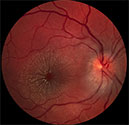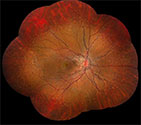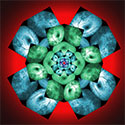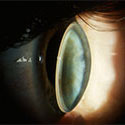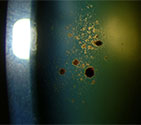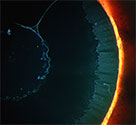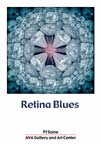

Photojournalism
Fine Art Prints
Ophthalmic Photography
• Retina
• Composites
• Fundus Quilts
• Externals
• Anterior Segment
• Beauty in Ophthalmic Photography
• Publications
Books & Posters
About PJ Saine
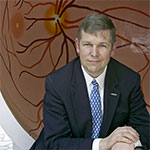
I Photograph Eyes
I've made my living as an ophthalmic photographer for more than 20 years. The phrase 'Ophthalmic Photographer' doesn't immediately register with most people - so I usually follow it up with the easier to understand: 'I photograph eyes.' This web page contains thoughts and internet links related to ophthalmic photography and examples of my work. It a record of my personal story and work philosophy.
Ophthalmic photography allows me to use my photographic talents to help people by gathering visual information for specialists in ophthalmology. Mostly I photograph retinas, but I also image corneas and lenses, the cells lining the inside of the cornea, and the facial area around eyes. I perform dye tests such as fluorescein angiography (FA) and ICG angiography (ICG-A), as well as specialized laser based testing such as Ocular Coherence Tomography (OCT).
The cameras I use in ophthalmic photography procedures are now digital, as opposed to film based. A 'Fundus Camera' is used to photograph the retina, and a 'Photo Slit Lamp' is used to photograph the eye's anterior segment. A special mirrored contact lens helps me photograph the interior of the eye where the cornea and iris meet (‘goniography’). I use a digital SLR with a Medical Nikkor lens for external photography.
Being a successful ophthalmic photographer requires balancing patient management with technical expertise. At the same time we are convincing a patient to sit quietly while we flash multiple bright lights into their eyes, we must be fully aware of the varied technical aspects of the image making process. A pleasant manner with patients, reinforced with large amounts of patience and perseverence, are requisites. So is a knack with complicated cameras and computers and keen attention to detail. The best ophthalmic photographers learn to see with 2 sets of eyes. We seek to understand the physician's vision as it guides us in obtaining medically useful images. We also use our own eyes - eyes that have been trained to seek the beauty in nature. The most successful ophthalmic photographs are clinically useful as well as visually interesting.
My personal reasons for choosing ophthalmic photography as a career were twofold. As a young altruistic photographer, I was interested in using my photography skills to help people. A major influence early in my career was W. Eugene Smith. You probably know this famous Life photographer from his photo essays that include ‘The Spanish Village’, ‘The Country Doctor’, and 'Nurse Midwife'. He wanted his photographs of WWII to be an indictment of war. He wanted his images to change human behavior by showing people the horrors of armed conflict. Our nation's more recent history - from Korea to Vietnam to Iraq - demonstrates that he did not (possibly could not?) accomplish his goal. I chose a smaller, but still worthwhile goal: to use my photography skills as part of a team that helps people see better.
Another draw to this field was the newness of the profession. Retinal photography was first performed (crudely) in 1886. Frederick Dimmer made some very sharp images of the retina just after the turn of the century. But the process was expensive and cumbersome and only a few research centers supported it. A turning point came in 1961, when Novotny and Alvis, two medical students from Indiana University, invented the test called Fluorescein Angiography. This test is used to create a 'road map' for retina specialists who perform laser treatments. Improvements in camera and techniques quickly followed and the Ophthalmic Photographers’ Society was formed in 1969. Now, over a million Fluorescein Angiography procedures (92250) are performed annually throughout the US. When I entered the job market in 1981, this was a new career opportunity that promised exciting possibilities for growth.
You might think that choosing a career photographing eyes would be extremely limiting. Let’s face it: as a body part, the eye takes up very little real estate. But I would argue with that assertion. Ophthalmic photography has given me a platform from which to explore many different areas of personal and professional growth. In addition to clinical ophthalmic photography, I have documented the good works of eye surgeons throughout the world using photojournalism skills. I have used my retinal images to create art and my photographs were featured in the Halle Berry/Bruce Willis movie "Perfect Stranger." My chosen career has given me opportunities to sharpen my teaching skills by presenting papers and lecturing for the Ophthalmic Photography Society, the American Academy of Ophthalmology, and Orbis International. I have published in a variety of peer reviewed scientific journals, as well as 4 books on ophthalmic photography. I have explored design and desktop publishing skills while preparing scientific posters for research meetings. And I have learned leadership skills through participation in the OPS Board of Directors and work related management responsibilities. Even my favorite pastime of book collecting has been impacted by my career: over the last 15 years I have amassed a collection of retinal atlases illustrated with fundus photographs. My clinical photographs have won numerous awards at OPS Scientific Exhibits and in 2003, the Ophthalmic Photographers’ Society honored me with their highest award: Outstanding Contribution to Ophthalmic Photography.
